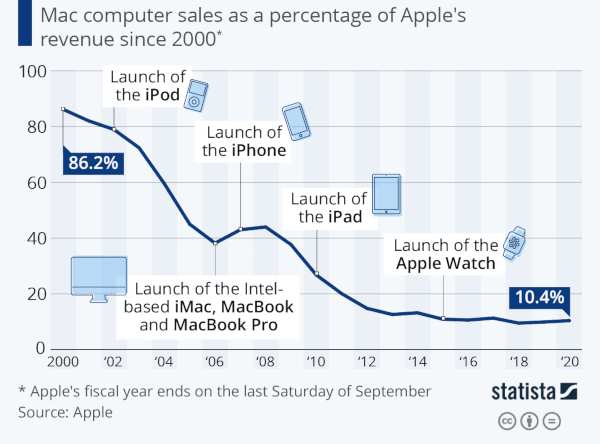
- The Macintosh, first launched in 1984, never gained significant market share.
- Based on operating system usage, macOS and OSX (combined) currently account for slightly more than seven percent of the market.
- Trends show that during late 2020 and early 2021, Mac usage declined as iOS/iPadOS usage increased.
- Although the Mac had its best quarterly revenue ever in 2020, the entire PC industry experienced the largest demand surge in a decade.
- There’s some indication that the iPad is cannibalizing Apple’s Macintosh business, as more users find a tablet sufficient for their computing needs.
iPad Cannibalizing Mac Sales
It was always the fear of Apple analysts and investors that one product would result in another’s demise. Much like a cannibal consumes its species’ flesh, iPad sales seem to be taking a bite out of the Mac. Indeed, Apple positions the iconic tablet as a “computer killer”, perhaps in the hopes of attenuating Microsoft’s desktop and laptop dominance. The company seems to have experienced some blowback from this strategy, with Mac users opting to replace their devices with cheaper and less profitable iPad models.
With a public under lockdown, most offices required employees to work from home. Many of these remote workers needed either a PC or a Mac. During much of 2020, the computer industry experienced a rebound as sheltered-at-home workers required new workstations.
Students and others in the workforce with lighter computing needs seemed to have gone for the iPad. Apple’s tablet is a perfect device for teleconferencing, with its large screen, front-facing camera, and light, ergonomic design. It’s also exceptionally cheap, with the base model costing only $329. Although, with only 32 GB of storage space, it’s more about baiting people into a higher-priced iPad.
Operating system usage statistics provide evidence of the transition. These figures show how many systems are currently detected running a specific operating system. It’s clear that, around October 2020, OS X/macOS usage began to decline as iOS/iPadOS usage ticked up.
The decline in macOS/OSX usage coincides with an increase in iPad sales as well. Demand for iPads surged in late 2020, as homebound workers and students required an inexpensive teleconferencing device. Additionally, some consumers seem to have replaced their older Macintosh with an iPad. Of course, many people own both and use the iPad more often.
Apple’s Marketing Favors iPad Over Mac
The danger of Apple’s iPad marketing is that it actively negates promotion of the Mac. By telling consumers that the iPad is a laptop replacement, many loyal Apple customers did just that. As their aging, well-built Macintoshes descended into obsolescence, no longer able to run the latest apps, people replaced these beasts of burden with iPads.
Apple’s marketing genius seems uncoordinated at the highest level, which is surprising, given its run by an expert in the field. The company could sell the iPad without detracting from the Mac. Perhaps, since so few people purchase a Macintosh, they believed this would harm PC makers more than Apple. Consumers can still buy a decent Windows-based laptop for less than an iPad with an unusably-low amount of storage space.
Apple must now struggle against its countervailing iPad momentum to push its newest generation of Macs running on homegrown silicon. The reality is that consumers don’t care about processors. They care about prices and brands. Even loyal Apple customers may opt for an iPad that’s one-third the price of a Mac. After all, Apple claims the iPad is a viable replacement for computers, and they push this message to consumers, school districts, universities, and corporations. Now they’re experiencing the blowback.
iPad More Reliable Than Mac
Perhaps consumers are better off with an iPad. The Mac used to be an extremely reliable computer; however, Apple’s obsession with thinness compromised quality over the years.
To create an even thinner MacBook, Apple invented a new keyboard mechanism. This “butterfly” mechanism quickly succumbed to failure from small particles ingressing under the keys. Even a tiny spec of dust could render a key useless or, even worse, cause it to repeat characters.
By design, Apple fused the keyboard into an assembly with the logic board, battery, and other components. Apple service technicians couldn’t just replace the keyboard or fix a key. If even one key broke, the entire assembly required replacement, costing $699 or more. In some cases, the keyboards broke multiple times, racking up massive repair bills, often exceeding the notebook computer’s initial price.
Furious consumers launched a class-action lawsuit. Apple eventually settled, offering four additional years of warranty protection for keyboard-related issues. Despite the settlement, yet another class-action case looms over Apple, due to this horrible keyboard design.
Another problem, known as “stage light effect”, materialized due to design changes made for the sake of thinness. With this problem, simply opening and closing the lid “too many times” wears away the display cable, resulting in screen shadows. It’s not what one expects from a $1200+ premium notebook computer.
Apple once again handled the issue with a limited repair program. The company doesn’t take such accountability for other Mac defects. If it affects fewer people, the Apple Store handles the issue, often charging users for repairs on defective products. The Fusion drive, a fixture in Apple’s iconic iMac, seems to fail with abundance. Since so few people purchase desktop Macs, there’s not enough harm to justify a service program.
Myriad issues plague the Mac, and they always will. The Mac is no longer Apple’s flagship product. Neglected for years, for rational reasons, it’s too far gone to recover. Apple’s move to put its own silicon in the Mac appears to be a cost-saving measure more than a push to advance the product. Apple can leverage A-series chip design while shifting money from Intel back to itself. Making the Mac more iPhone-like makes it less expensive to produce.
Given the current state of the Mac, the iPad looks pretty good. It doesn’t come with a keyboard, which benefits the loyal Apple customer with reliability. There are few moving parts on an iPad. I still have a 10-year-old iPad 2 that barely works due to a dead slow operating system, not hardware failure.
Even the iPad is far from perfect. Often delivered to consumers with conspicuous bends in the frame, Apple’s iconic tablet is a reminder that its quality isn’t superior. According to Apple executive Dan Riccio, bent iPads are normal. The company that continually reminds us of how perfect its products are expects consumers to accept a jarring defect.
iPad Cheaper Than Mac
The iPad’s deceptively low price may be another reason why loyal Apple customers are ditching their MacBooks for an iPad. The base model iPad starts at $329. Of course, with only 32 GB of storage space, it’s a non-starter for anyone in 2021. With the operating system, requisite free space, and Apple’s first-party apps installed, this base-model iPad barely has room to store three HD movies.
A reasonably equipped iPad costs $429, which is a steal compared to a MacBook. Myriad Windows PCs and Chromebooks cost as much or less than this rudimentary iPad with outdated cameras and a lackluster display. Nonetheless, if you’re in love with Apple and no longer require a Mac, the iPad is a legitimate choice.
Will Apple Ditch The Macintosh?
Apple is a massive, global corporation depending on economies of scale effects to grow revenues. They need simple, blockbuster products enticing hundreds of millions of customers. The Mac was never and will never achieve this. From its inception, it’s a computer for rebels and those who think differently.
The Mac has become a bit of an albatross for the Cupertino tech giant. As previously mentioned, measured by operating system usage, the Mac has a tiny market share. With all Macs in use today, Apple can only take hold of 7% of the market.
While Mac sales have increased, the world has grown in population, and developing nations continue to embrace technology. Mac sales growth still doesn’t outpace the entire computer market. As of today, Mac sales account for a little over 10% of Apple’s revenues.
Research and development for the Mac is expensive. As Apple takes on Mac chip development, a one-off of its A-series processors, the company spends even more. Because the Mac makes up less of Apple’s revenues, the company may exit the computer business altogether, much like Microsoft bailed out of the smartphone industry.
Whether the Mac lives on or not, it’s clear that Apple doesn’t take the product as seriously as in the past. The entire Mac lineup goes for years without a refresh, while the iPhone gets an annual update. The only product Apple neglects more than the Mac is Apple TV — a truly pathetic, misfit of a device with laughable market share.
Whatever happened to the blockbuster iPod? It’s now an amusing, low-end device with a practically obsolete processor. The Mac may suffer a worse fate.
A small faction will still buy the Mac, primarily due to Apple’s branding power. It’s not better than a comparably priced Windows PC, but it brandishes the Apple logo, which is enough for some. Apple is a lifestyle brand, and loyalty runs deep for some.
The problem is that Apple’s own iPad tablet is capable enough for most computing tasks. Between an abundance of inexpensive, reliable Windows PCs and Apple’s Mac-killing iPad, the Macintosh doesn’t seem to have a bright future. Consumers may want to avoid Apple’s neglected computer line in favor of more reliable and affordable options.



